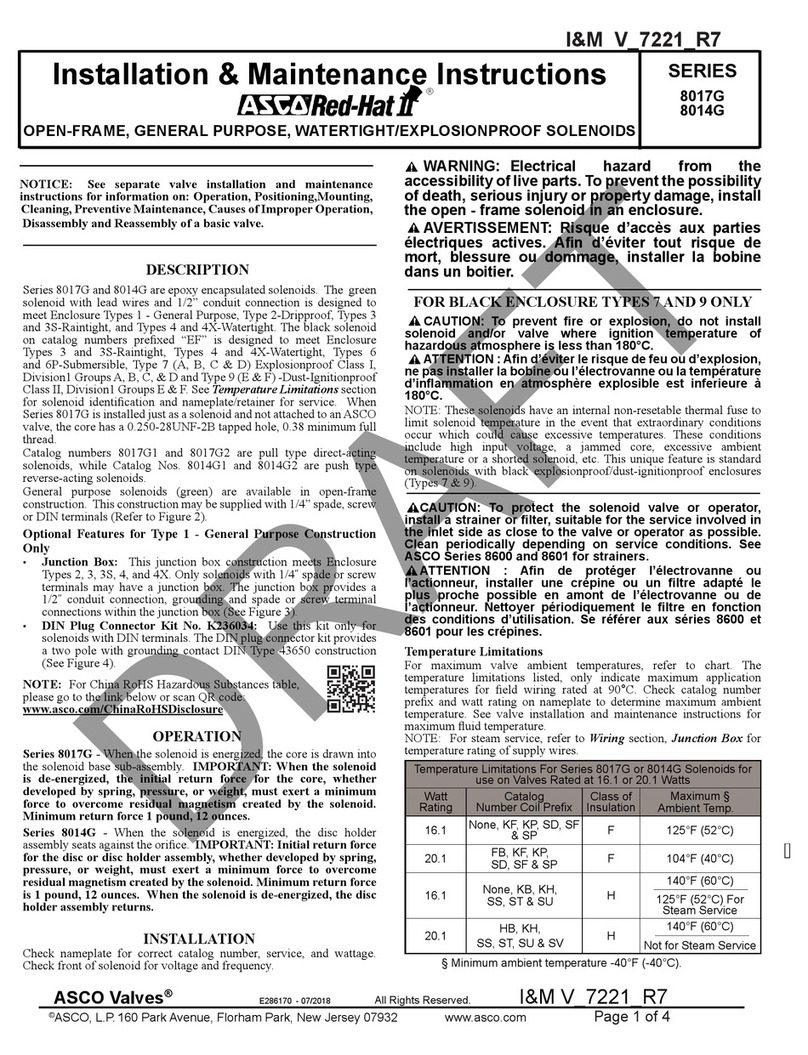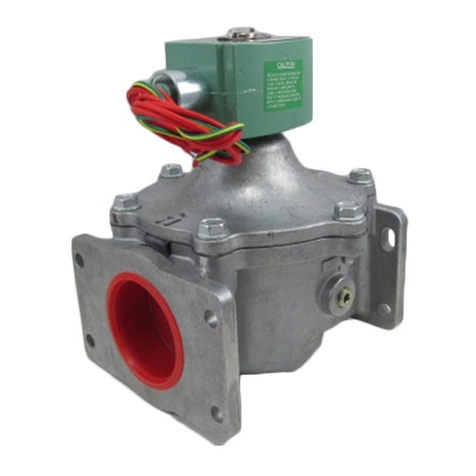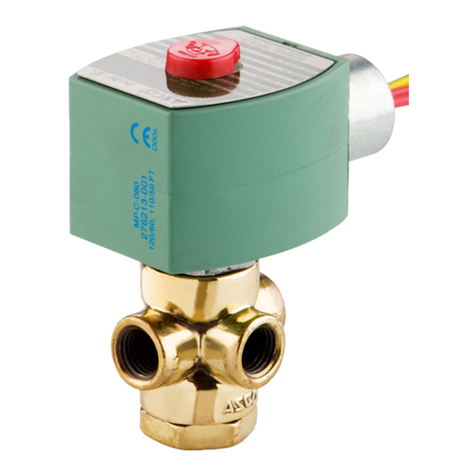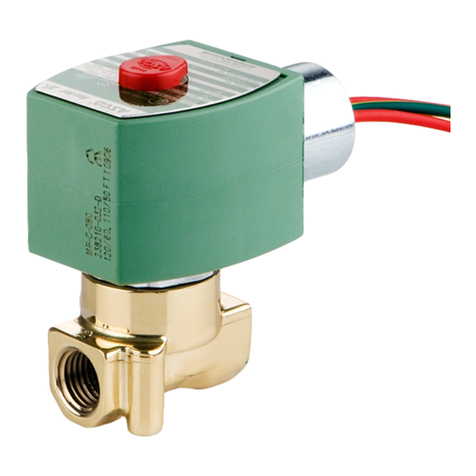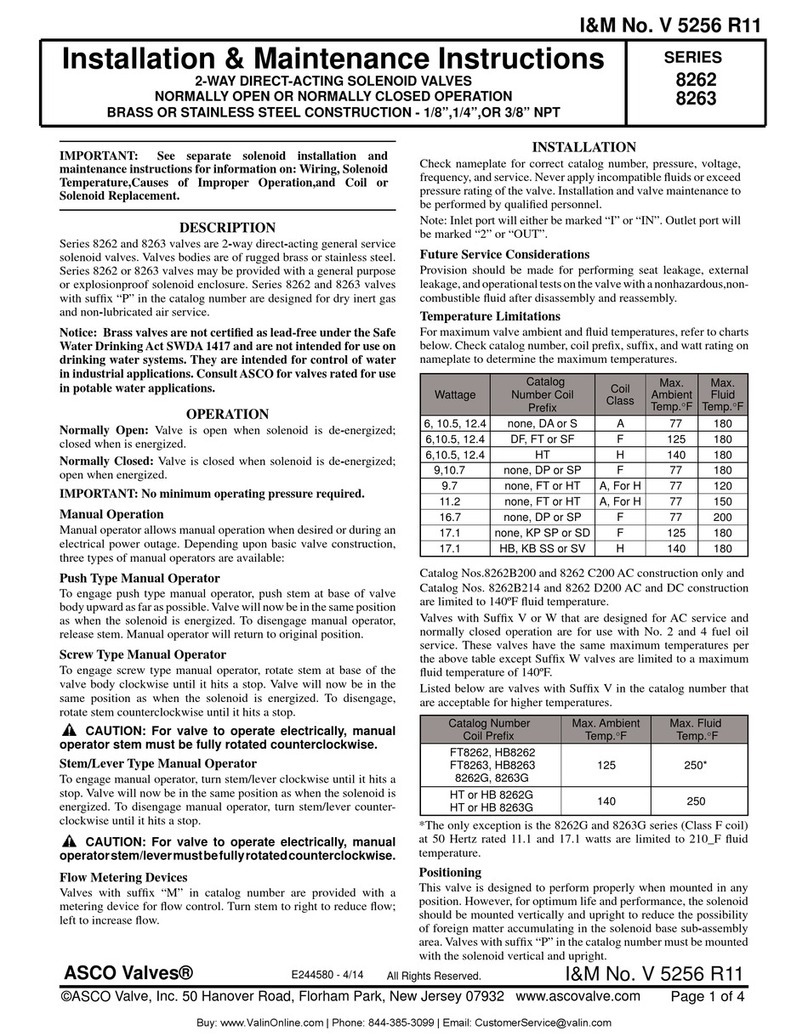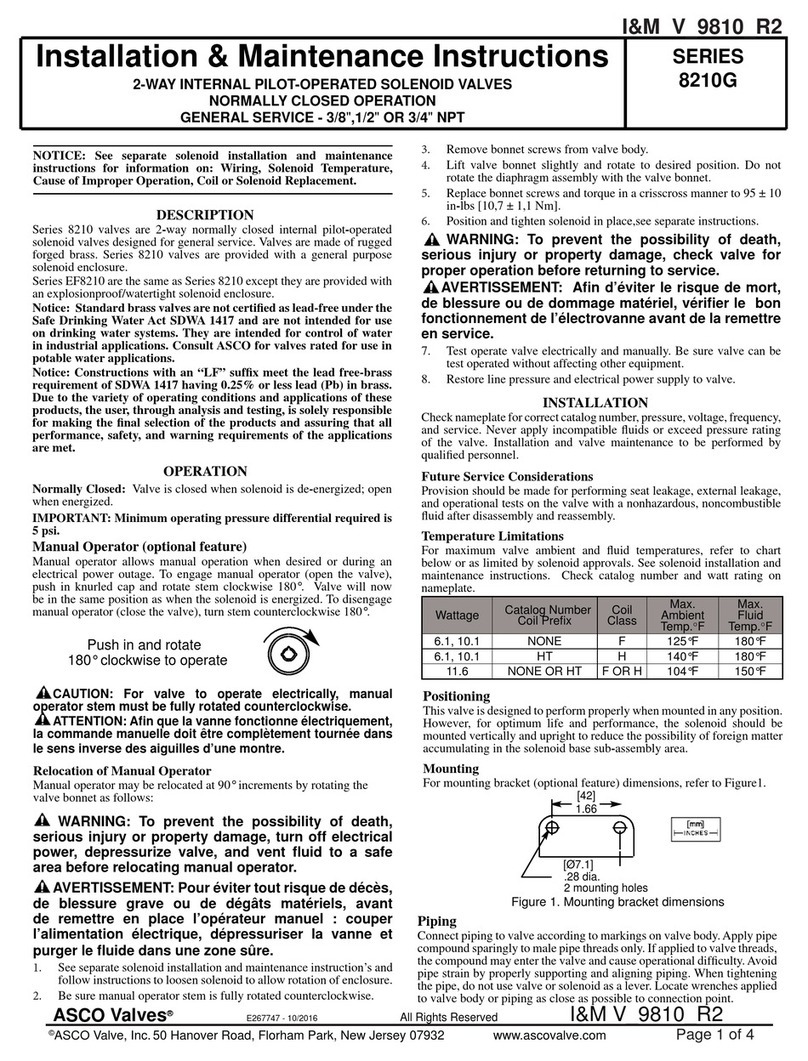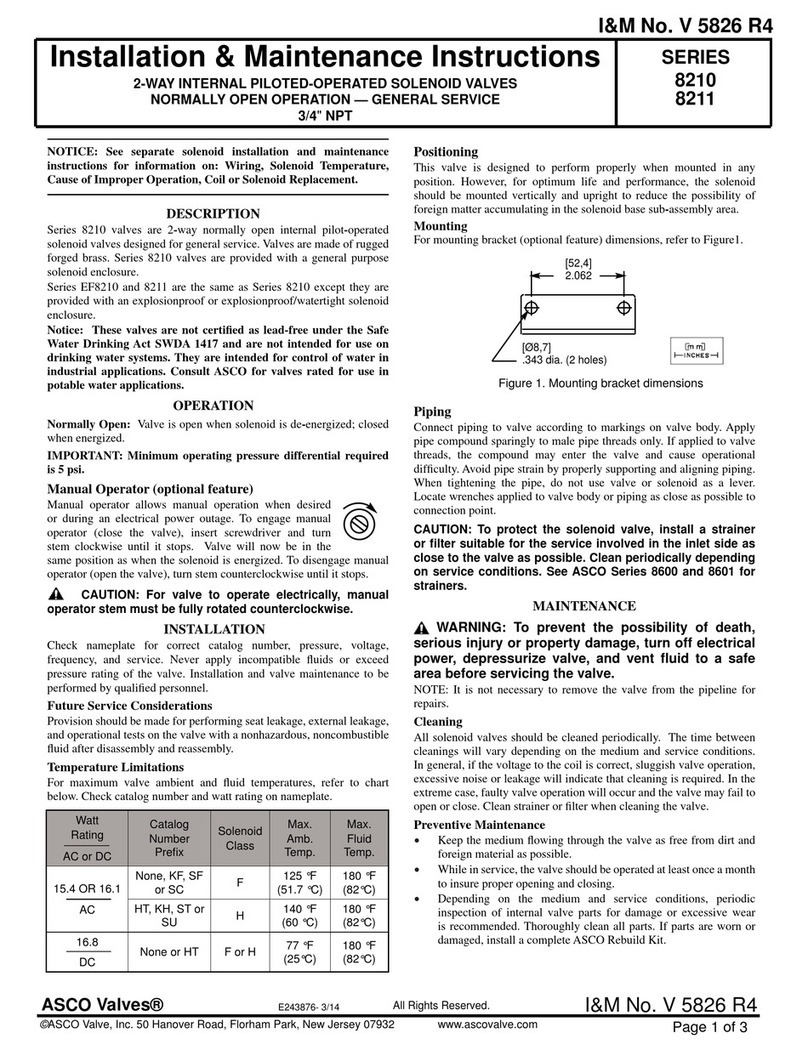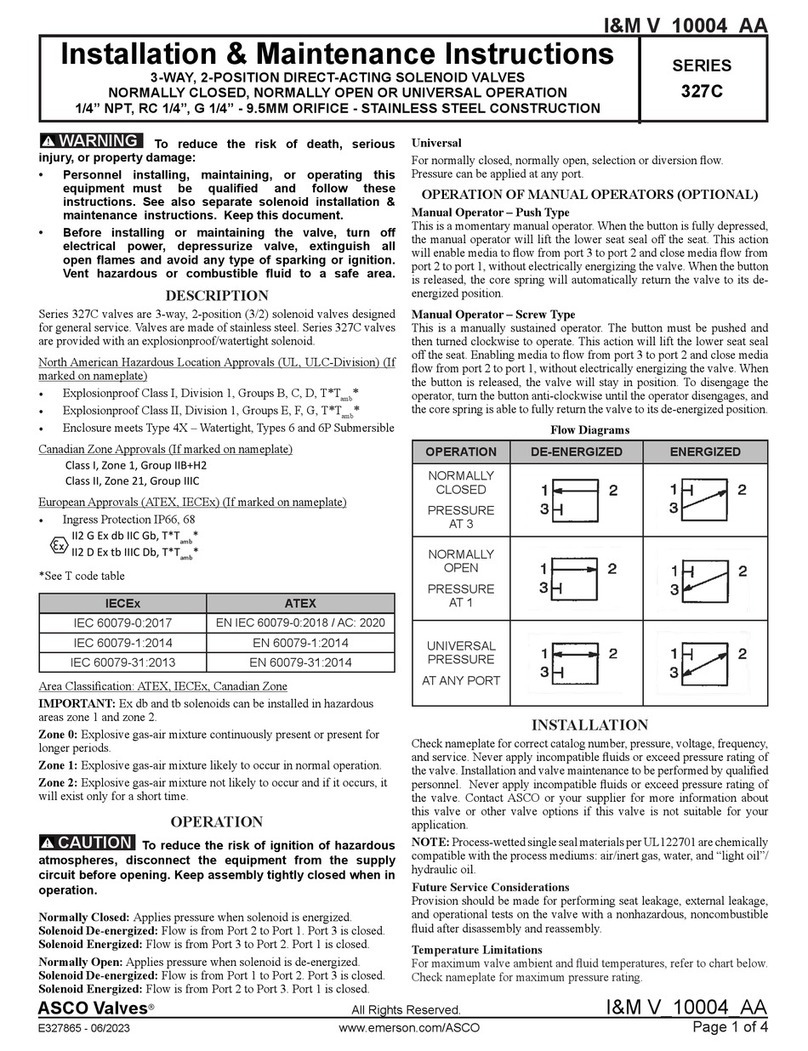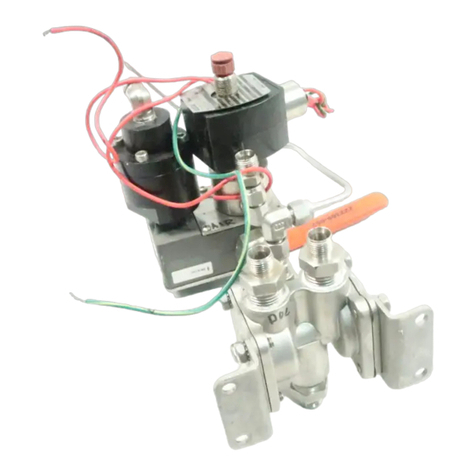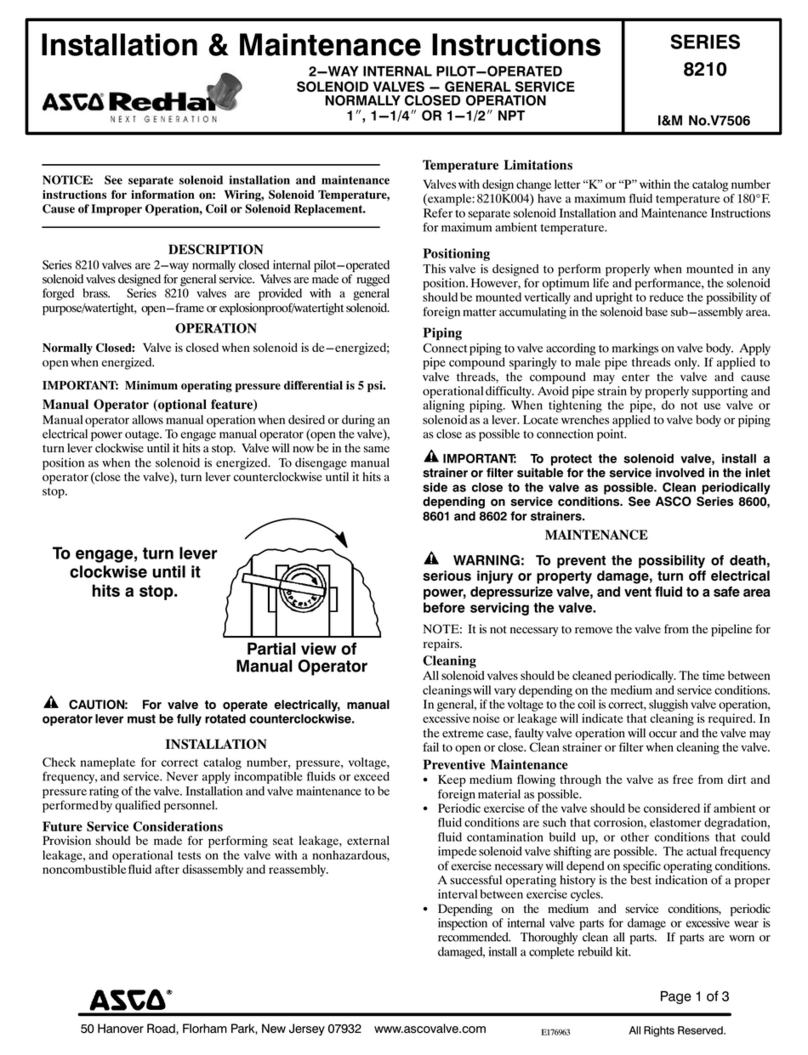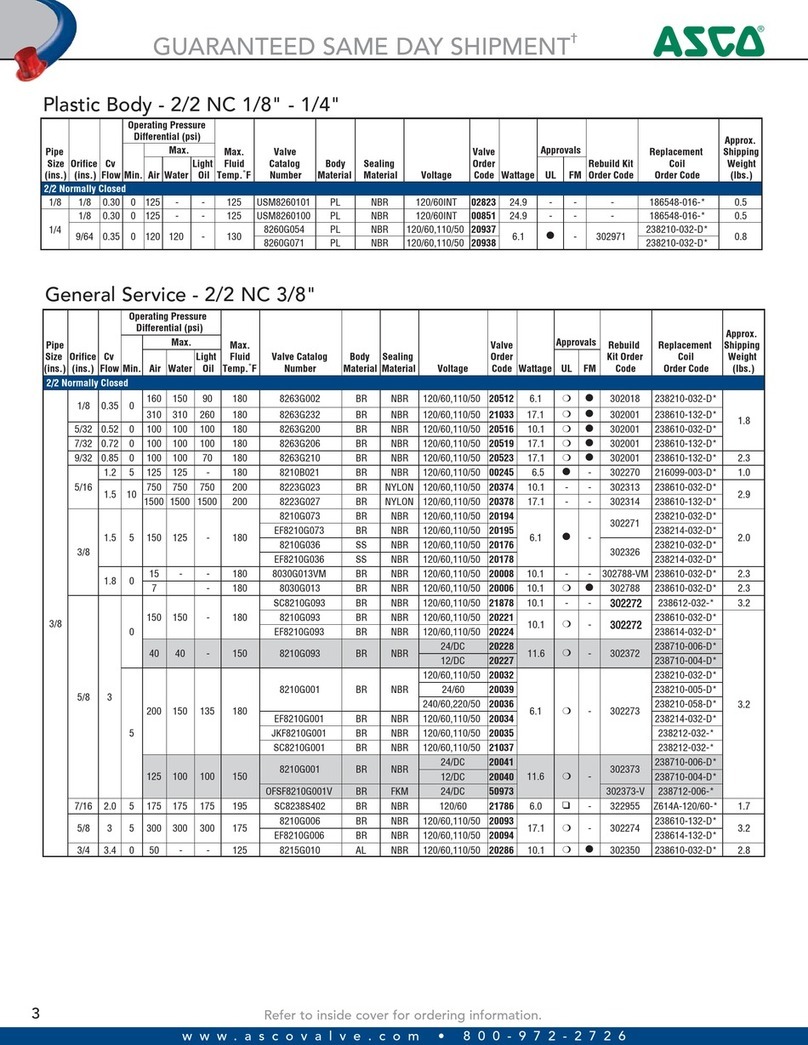
Page 2 of 4 I&M No. V_5452_R7
©ASCO Valve, Inc.50 Hanover Road, Florham Park, New Jersey 07932 www.ascovalve.com
Apply pipe compound sparingly to male pipe threads only. If applied to
valve threads, the compound may enter the valve and cause operational
difficulty. Avoid pipe strain by properly supporting and aligning piping.
When tightening the pipe, do not use valve or solenoid as a lever.
Locate wrenches applied to valve body or piping as close as possible to
connection point.
CAUTION: To protect the solenoid valve, install a strainer
or filter, suitable for the service involved, in the inlet side as
close to the valve as possible. Clean periodically depending
on service conditions. See ASCO Series 8600 and 8601 for
strainers.
ATTENTION: Afin de protéger l’électrovanne ou
l’actionneur, installer une crépine ou un filtre adapté le
plus proche possible en amont de l’électrovanne ou de
l’actionneur. Nettoyer périodiquement le filtre en fonction
des conditions d’utilisation. Se référer aux séries 8600 et
8601 pour les crépines.
MAINTENANCE
WARNING: To prevent the possibility of death,
serious injury or property damage, turn off
electrical power, depressurize solenoid operator
and/or valve, and vent fluid to a safe area before
servicing.
AVERTISSEMENT: Pour éviter tous danger de
mort, de blessure grave ou de dommage matériel,
avant d’intervenir sur la vanne, couper le courant,
purger la vanne dans une zone sécurisée.
NOTE: It is not necessary to remove the valve from the pipeline for repairs.
Cleaning
All solenoid valves should be cleaned periodically. The time between
cleanings will vary depending on the medium and service conditions.
In general, if the voltage to the coil is correct, sluggish valve operation,
excessive noise or leakage will indicate that cleaning is required. In the
extreme case, faulty valve operation will occur and the valve may fail
to open or close. Clean valve strainer or filter when cleaning the valve.
Preventive Maintenance
• Keep the medium flowing through the valve as free from dirt and
foreign material as possible.
• While in service, the valve should be operated at least once a month
to insure proper opening and closing.
• Dependingon themediumand serviceconditions,periodic inspection
of internal valve parts for damage or excessive wear is recommended.
Thoroughly clean all parts. If parts are worn or damaged, install a
complete ASCO Rebuild Kit.
Causes Of Improper Operation
• Incorrect Pressure: Check valve pressure. Pressure to valve must be
within range specified on nameplate.
• Excessive Leakage: Disassemble valve and clean all parts. If parts
are worn or damaged, install a complete ASCO Rebuild Kit.
Valve Disassembly
1. Disassemble valve in an orderly fashion. Use exploded views for
identification and placement of parts.
2. Remove solenoid, see separate instructions.
3. Unscrew solenoid base sub-assembly and remove core spring from
top of core assembly.
4. For valves made of stainless steel (Figure 2) with a manual operator,
unscrew manual operator body. Then remove bonnet gasket, stem
retainer, stem assembly and stem gasket.
5. For valves made of brass (Figure 3) with a manual operator, it is not
necessary to disassemble manual operator for normal maintenance
(cleaning). However, if a rebuild kit is being installed, remove stem
pin, manual operator stem, stem spring, and stem gaskets.
6. Remove bonnet screws, valve bonnet, core/diaphragm sub-assembly
and body gasket.
7. All parts are now accessible for cleaning or replacement. If parts are
worn or damaged, install a complete ASCO Rebuild Kit.
Valve Reassembly
1. Reassemble valve using exploded views for identification and
placement of parts.
2. Lubricate all gaskets with Molykote®111 Compound or equivalent
high-grade silicone grease.
3. Positionbodygasketandcore/diaphragmsub-assemblyinvalvebody.
Locate bleed hole in core/diaphragm sub-assembly approximately
45°from valve outlet.
4. Install core spring in top of core assembly. Wide end of core spring in
core first; closed end protrudes from top of core.
5. Replace valve bonnet and bonnet screws on valve body. Torque
bonnet screws in a crisscross manner to 50 ± 5 in-lbs [5,7 ± 0,6 Nm].
6. For valves of stainless steel construction (Figure 2) with a manual
operator proceed as follows:
A. Install stem gasket on stem assembly and into manual operator
body.
B. Position stem retainer on manual operator body. Be sure captive
spacer on stem assembly is on the Outside of the stem retainer.
C. Install bonnet gasket and manual operator body. Then torque
manual operator body to 175 ± 25 in-lbs [19,8 ± 2,8 Nm].
D. After assembly, operate manual operator to be sure there is
no misalignment or binding. If binding occurs, loosen manual
operator body and move stem retainer slightly clockwise. Re-
torque and check for proper operation. Then rotate manual
operator stem counterclockwise as far as possible.
7. For valves of brass construction (Figure 3) with a manual operator,
proceed as follows:
A. Install outer stem gasket and inner stem gasket on manual
operator stem as shown.
B. Install stem spring, and stem assembly with gaskets into valve
bonnet.
C. Push stem assembly into valve bonnet;align stem pin hole and
install stem pin.
D. Operate manual operator to be sure there is no misalignment or
binding. Then rotate manual operator stem counterclockwise as
far as possible.
8. Replace bonnet gasket and solenoid base sub-assembly. Torque
solenoid base sub-assembly to 175 ± 25 in-lbs [19,8 ± 2,8 Nm].
9. Install solenoid, see separate instructions and make electrical
hookup.
WARNING: To prevent the possibility of death,
personal injury or property damage, check valve
for proper operation before returning to service.
Also perform internal seat and external leakage
tests with a nonhazardous, noncombustible fluid.
AVERTISSEMENT: Afin d’éviter le risque de
mort, de blessure ou de dommage matériel,
vérifier le bon fonctionnement de l’électrovanne
avant de la remettre en service. Contrôler aussi
les fuites externe et interne avec un fluide non
dangereux.
10.Restore line pressure and electrical power supply to valve.
11.After maintenance is completed, operate the valve a few times to be
sure of proper operation. A metallic click signifies the solenoid is
operating.
ORDERING INFORMATION
FOR ASCO REBUILD KITS
Parts marked with an asterisk (*) in the exploded view are supplied in
Rebuild Kits. When Ordering Rebuild Kits for ASCO valves, order the
Rebuild Kit number stamped on the valve nameplate. If the number of
the kit is not visible, order by indicating the number of kits required, and
the Catalog Number and Serial Number of the valve(s) for which they
are intended.
